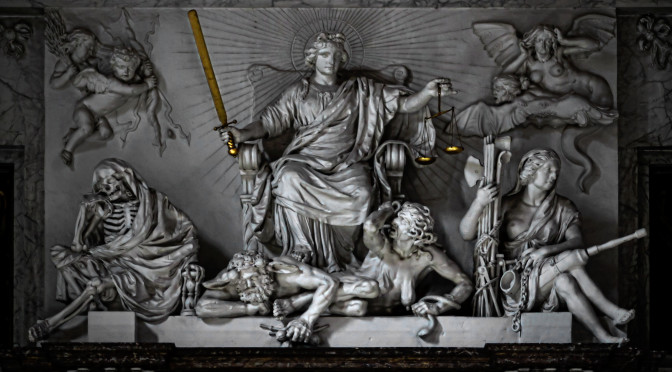In a recent article in Isis, historian Richard Serjeantson traces Francis Bacon’s coinage and usage of the phrase “interpreting nature”. Bacon, Serjeantson argues, was the first to come up with the notion of an “interpretation of nature”. The author delves into sixteenth century sources to find where the word “interpret” comes from. Apparently not from the world of natural history, philosophy, medicine, magic, or even theology – Serjeantson discovers that the word interpretation comes from the field of Law. When attorneys or lawyers had to defend or accuse a case or person, laws and rules were interpreted to fit certain circumstances. As a lawyer, Bacon was familiar with its practices.
Serjeantson makes a strong case for this thesis in his article. This post will look into one small element of Serjeantson’s article – namely, the illustration the author uses to underscore his argument. The picture in question is a detail taken from the title page of Pardoux Duprat, Lexicon juris civilis et canonici (Lyon, 1567). The caption that Serjeantson uses with this image is “Law overcomes Nature, represented as Pan.” In his essay he refers to this illustration, writing that:
“… Bacon’s vision of natural investigation had its origin in the processes of legal inquisitio. If this is so, then Bacon’s general theory of the “interpretation of nature” may perhaps also be regarded as having a significantly legal foundation. (see Figure 1…).”
With this picture, Serjeantson not only connects Law to Nature but Law is considered to rule over Nature.
The figure that Serjeantson uses is a small section of the title page of Pardoux Duprat, Lexicon juris civilis et canonici. It shows a standing female holding a law book in her right hand and with her left hand she holds a kneeling figure by his hair. She seems to be hitting the kneeling man with the book. Serjeantson explains this man as Nature in the guise of Pan. Pan is the god of wild nature, mountains, fields, groves, woodland, as well as fertility, hunting, and rustic music. He is depicted with the horns and legs of a goat. The figure in the picture, however, has normal legs and does not appear to have horns on his head. The things on his head seem to me to be donkey’s ears. Considering this, the man can only be one mythological figure: King Midas.
A short (re-)introduction of King Midas is in order. According to Ovid’s Metamorphosis, (Bk XI:85-145 and Bk XI:172-193), Midas made two poor judgements. First, as a reward, Bacchus gave Midas control over the choice of a gift, and Midas chose that he could turn everything he touched into gold. This included his food and drink. Hungry and thirsty he repented his wish. After he was cured from his self-imposed curse, he became a judge to decide whether Pan or Apollo was the best flutist. Midas chose Pan, upon which Apollo awarded the unsuited judge a pair of donkey’s ears, since Midas did not use his ears properly.
A donkey or a donkey’s face was one of the symbols of stupidity and ignorance, as described by the Italian iconographer Cesare Ripa (c. 1560 – c. 1622). Ripa had compiled a famous book based on Egyptian, Greek and Roman emblematical representations, called Iconologia overo Descrittione Dell’imagini Universali cavate dall’Antichità et da altri luoghi (printed in 1593). The stories were known before, but assembled in this book they became popular among scholars, artists, poets and writers. Ripa’s explanations and figurations were widely known in Europe.
Midas, with his donkey’s ears and his bad judgement, was the embodiment of ignorance and stupidity. The figure of Midas subjugated by law was not an uncommon symbol. For example, a famous sculpture can be seen in the Citizens Hall over the entrance to the courtroom in the former City Hall of the Amsterdam (today the Royal Palace Amsterdam). This group of marble figures, made by Artus Quellinus in 1662, shows that the knowledge of law is essential for making just decisions, to choose right over wrong. Considering the above, a more appropriate interpretation of Duprat’s frontispiece is that Law slams the book in Midas’s face, not Pan’s.
I do not wish to criticize Serjeantson’s overarching argument about Bacon’s inspiration to use the word interpretation – the argument he makes in his article is sound. However, we have to consider how to use and explain symbols. Symbols are a means of communication between groups of people, and give meaning and significance to various social and cultural processes. In this case, the symbol of Justice and King Midas tells us that through rules and regulations we can control stupidity and ignorance. Law overcomes bad judgement and not Nature.
o-o-o
Alette Fleischer holds an MA in Art history and a PhD in the History of Science.
Image credits:
-Royal Palace sculpture: ‘Banned by Justice‘ photo by Dominik Bartsch, licensed under CC BY 2.0.
-Detail from the title page of Pardoux Duprat, Lexicon juris civilis et canonici. From Google Books


